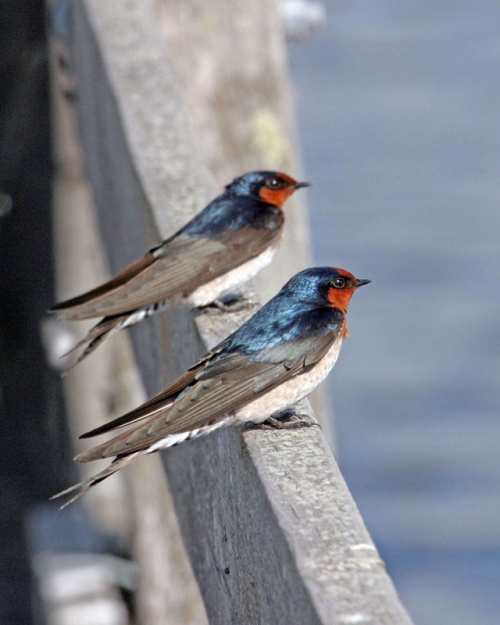(Linked to genus) |
Sbarnhardt (talk | contribs) (Edited username Mzungu to Ken Doy x 1 & image pixel to 500px) |
||
| (7 intermediate revisions by 4 users not shown) | |||
| Line 1: | Line 1: | ||
| − | {{ | + | [[Image:Welcome_Swallow.jpg|thumb|500px|right|Photo © by {{user|Tony+Brown|Tony Brown}}<br />Cockburn Wetlands Perth, [[Western Australia]], May 2006]] |
| − | [[ | ||
;[[:Category:Hirundo|Hirundo]] neoxena | ;[[:Category:Hirundo|Hirundo]] neoxena | ||
| − | + | ||
| − | |||
==Identification== | ==Identification== | ||
| − | ==Distribution & Taxonomy== | + | 13–17 cm (5-6¾ in) |
| + | *Reddish-chestnut forehead and throat | ||
| + | *Metallic blue-black upperparts | ||
| + | *Blackish-brown wings and tail | ||
| + | *Light grey underparts | ||
| + | *Long forked tail, with a row of white spots on the individual feathers<br /> | ||
| + | '''Young''' birds have a whitish forehead and throat, and have shorter tail streamers | ||
| + | |||
| + | ==Distribution== | ||
| + | [[Image:Welcome Swallow 2-207.jpg|thumb|350px|right|Juvenile<br />Photo © by {{user|Ken+Doy|Ken Doy}}<br />Buckleys Hole, Bribie Island, [[Queensland]], [[Australia]], November 2018]] | ||
| + | [[Australia]] and [[New Zealand]]. | ||
| + | ==Taxonomy== | ||
| + | ====Subspecies==== | ||
| + | Two recognized subspecies<sup>[[#References|[1]]]</sup>: | ||
| + | *''H. n. carteri'': | ||
| + | :*South-western [[Western Australia]] (North West Cape to about Eyre); winters to the north | ||
| + | *''H. n. neoxena'': | ||
| + | :*Breeds in south-eastern and eastern [[Australia]], including [[Tasmania]], with some of the population migrating north to north-eastern Australia, and on Norfolk and Lord Howe Islands. In the mid 20th century also colonized [[New Zealand]], Norfolk Island, and the Chatham Islands | ||
| + | |||
==Habitat== | ==Habitat== | ||
| + | A wide variety of open habitats, including coasts, cultivation and inhabited areas, usually near water. They roost in wetlands. | ||
==Behaviour== | ==Behaviour== | ||
| + | ====Behaviour==== | ||
| + | The open cup nest is formed from mud and grass, lined with feathers and fur placed on a rock wall or side of a building. It is built by both adults. The clutch contains 3-5 eggs which are incubated by the female for 14-21 days. Both parents feed the young which fledge after a further 14-21 days. There are usually two broods. | ||
| + | ====Diet==== | ||
| + | Their diet consists of insects such as stone-flies, beetles, flies and bugs, taken on the wing. | ||
| + | ==References== | ||
| + | #{{Ref-Clements6thAug18}}#Handbook of the Birds of the World Alive (retrieved November 2015) | ||
| + | #Birds in Backyards | ||
| + | {{ref}} | ||
==External Links== | ==External Links== | ||
{{GSearch|Hirundo+neoxena}} | {{GSearch|Hirundo+neoxena}} | ||
| − | + | <br /> | |
| − | [[Category: | + | {{Video|Welcome_Swallow}} |
| + | |||
| + | |||
| + | [[Category:Birds]] [[Category:Hirundo]] [[Category:Videos]] | ||
Revision as of 19:21, 8 December 2020
- Hirundo neoxena
Identification
13–17 cm (5-6¾ in)
- Reddish-chestnut forehead and throat
- Metallic blue-black upperparts
- Blackish-brown wings and tail
- Light grey underparts
- Long forked tail, with a row of white spots on the individual feathers
Young birds have a whitish forehead and throat, and have shorter tail streamers
Distribution
Australia and New Zealand.
Taxonomy
Subspecies
Two recognized subspecies[1]:
- H. n. carteri:
- South-western Western Australia (North West Cape to about Eyre); winters to the north
- H. n. neoxena:
- Breeds in south-eastern and eastern Australia, including Tasmania, with some of the population migrating north to north-eastern Australia, and on Norfolk and Lord Howe Islands. In the mid 20th century also colonized New Zealand, Norfolk Island, and the Chatham Islands
Habitat
A wide variety of open habitats, including coasts, cultivation and inhabited areas, usually near water. They roost in wetlands.
Behaviour
Behaviour
The open cup nest is formed from mud and grass, lined with feathers and fur placed on a rock wall or side of a building. It is built by both adults. The clutch contains 3-5 eggs which are incubated by the female for 14-21 days. Both parents feed the young which fledge after a further 14-21 days. There are usually two broods.
Diet
Their diet consists of insects such as stone-flies, beetles, flies and bugs, taken on the wing.
References
- Clements, J. F., T. S. Schulenberg, M. J. Iliff, D. Roberson, T. A. Fredericks, B. L. Sullivan, and C. L. Wood. 2018. The eBird/Clements checklist of birds of the world: v2018. Downloaded from http://www.birds.cornell.edu/clementschecklist/download/
- Handbook of the Birds of the World Alive (retrieved November 2015)
- Birds in Backyards
Recommended Citation
- BirdForum Opus contributors. (2024) Welcome Swallow. In: BirdForum, the forum for wild birds and birding. Retrieved 25 April 2024 from https://www.birdforum.net/opus/Welcome_Swallow
External Links





